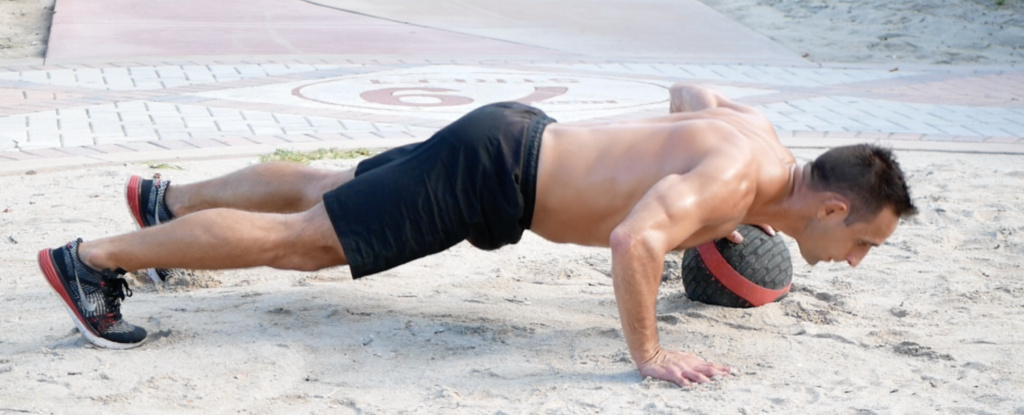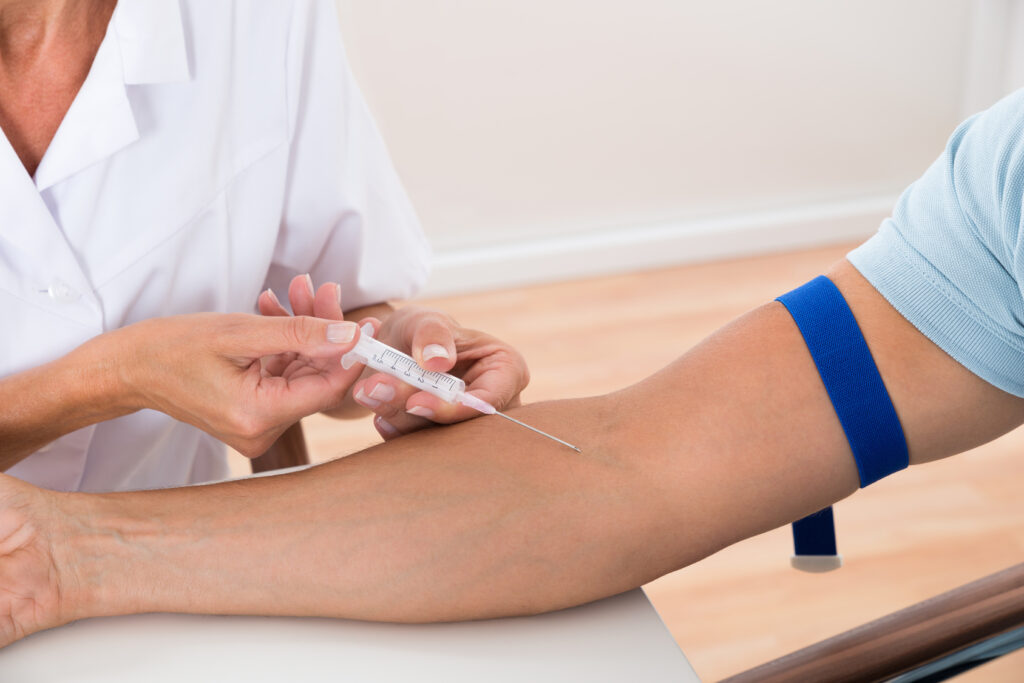
Movement can also be a form of pain relief. The benefits far outweigh the risks if the program is prescribed appropriately. These include improved blood flow, muscular strength, tissue healing and overcoming the fear of movement. Continuing to exercise body parts that are not injured, or movements that do not aggravate injury, can dramatically improve time for return to sport.

I hear this almost every day. An athlete tells me that they are “just resting, and not doing anything.” This might be good for a very short time (like a day or two at most), to relieve swelling, pain and maybe overcome fear of movement. However, complete rest more than a week causes the muscles, tendons, ligaments, bones and joints to deteriorate. While it might not appear to be detrimental at first, many hours of exercise are thrown out the window in even that short period of time.

So what additional benefits can exercise offer that medication, injections and rest cannot?

Medicine and injections help relieve pain, reduce swelling and might help you overcome fear of movement. However, they fall short in the tissue strengthening department. In fact, cortisone shots in particular have been shown to make tendons even weaker. This can cause a false sense of security, possibly an earlier return to sports, but a greater risk of reinjury due to a weakened tendon and ligaments.
Exercise, on the other hand, has such a strong track record and and long list of positive outcomes that Dr. Robert Butler, the founder of the National Institute of Aging said this:
The technique with prescribing the proper exercise regarding frequency, intensity, time and type, has many layers.
The first step would be to take a history of when your injury happened, how it happened, why it happened and what activities are limited because of your pain.
Next would be to have a look at how well you move- if you have pain with movement, loss of movement or fear of movement.
What does the range of motion look like? Compare that to the other side (if its your shoulder or leg).
How about strength? Is the injured limb strong or weak?
What about more sport-specific movements? Think back to the last time you trained or worked out. Which movements in particular did you not feel comfortable performing?
Which part of the movement did you avoid or “work around” in order to complete it. This may help you better explain to your therapist or coach what is happening & how to approach resolving the pain.
Thirdly, properly identifying the type of tissue is injured.
Bones, tendons, ligaments, muscle and joints all respond to specific stresses.
Once the correct tissue is identified, a program can be designed to address the issues that were identified. Correct loading of joints, muscle recruitment, balance and coordination should all be considered.
Being able to figure out which structures are injured will help determine which exercises are appropriate for your specific condition. The number of sets, reps, intensity, frequency and any necessary adjustments require a skillful eye to keep you moving in the right direction.
This is where the art and science of understanding the human body from its cells to social interaction are integrated to ensure that the athlete has a comprehensive and individually designed approach.
If you are unsure of what your next step should be, speak to a trusted health care provider. If you’re in the Miami area, you can always reach out to me, I would love to help.

Proper food choices have been a source of pain relief for thousands of years. The focus should be on consuming anti-inflammatory foods, avoiding pro-inflammatory foods or specific nutrients for building blocks of tissue healing. There are generally no drawbacks except for caution with specific foods that interact with medications (speak to your medical doctor about that).

Movement can also be a form of pain relief. The benefits far outweigh the risks if the program is prescribed appropriately. These include improved blood flow, muscular strength, tissue healing and overcoming the fear of movement. Continuing to exercise body parts that are not injured, or movements that do not aggravate injury, can dramatically improve time for return to sport.

I hear this almost every day. An athlete tells me that they are “just resting, and not doing anything.” This might be good for a very short time (like a day or two at most), to relieve swelling, pain and maybe overcome fear of movement. However, complete rest more than a week causes the muscles, tendons, ligaments, bones and joints to deteriorate. While it might not appear to be detrimental at first, many hours of exercise are thrown out the window in even that short period of time.

So what additional benefits can exercise offer that medication, injections and rest cannot?

Medicine and injections help relieve pain, reduce swelling and might help you overcome fear of movement. However, they fall short in the tissue strengthening department. In fact, cortisone shots in particular have been shown to make tendons even weaker. This can cause a false sense of security, possibly an earlier return to sports, but a greater risk of reinjury due to a weakened tendon and ligaments.
Exercise, on the other hand, has such a strong track record and and long list of positive outcomes that Dr. Robert Butler, the founder of the National Institute of Aging said this:
The technique with prescribing the proper exercise regarding frequency, intensity, time and type, has many layers.
The first step would be to take a history of when your injury happened, how it happened, why it happened and what activities are limited because of your pain.
Next would be to have a look at how well you move- if you have pain with movement, loss of movement or fear of movement.
What does the range of motion look like? Compare that to the other side (if its your shoulder or leg).
How about strength? Is the injured limb strong or weak?
What about more sport-specific movements? Think back to the last time you trained or worked out. Which movements in particular did you not feel comfortable performing?
Which part of the movement did you avoid or “work around” in order to complete it. This may help you better explain to your therapist or coach what is happening & how to approach resolving the pain.
Thirdly, properly identifying the type of tissue is injured.
Bones, tendons, ligaments, muscle and joints all respond to specific stresses.
Once the correct tissue is identified, a program can be designed to address the issues that were identified. Correct loading of joints, muscle recruitment, balance and coordination should all be considered.
Being able to figure out which structures are injured will help determine which exercises are appropriate for your specific condition. The number of sets, reps, intensity, frequency and any necessary adjustments require a skillful eye to keep you moving in the right direction.
This is where the art and science of understanding the human body from its cells to social interaction are integrated to ensure that the athlete has a comprehensive and individually designed approach.
If you are unsure of what your next step should be, speak to a trusted health care provider. If you’re in the Miami area, you can always reach out to me, I would love to help.

Injections are concentrated forms of medicine that usually contain very strong anti-inflammatories & pain reducers. The benefits, like medicine, include relief from pain and reduction in swelling, blocking of nerve signals that send pain. The cons are similar to medicine as well.

Proper food choices have been a source of pain relief for thousands of years. The focus should be on consuming anti-inflammatory foods, avoiding pro-inflammatory foods or specific nutrients for building blocks of tissue healing. There are generally no drawbacks except for caution with specific foods that interact with medications (speak to your medical doctor about that).

Movement can also be a form of pain relief. The benefits far outweigh the risks if the program is prescribed appropriately. These include improved blood flow, muscular strength, tissue healing and overcoming the fear of movement. Continuing to exercise body parts that are not injured, or movements that do not aggravate injury, can dramatically improve time for return to sport.

I hear this almost every day. An athlete tells me that they are “just resting, and not doing anything.” This might be good for a very short time (like a day or two at most), to relieve swelling, pain and maybe overcome fear of movement. However, complete rest more than a week causes the muscles, tendons, ligaments, bones and joints to deteriorate. While it might not appear to be detrimental at first, many hours of exercise are thrown out the window in even that short period of time.

So what additional benefits can exercise offer that medication, injections and rest cannot?

Medicine and injections help relieve pain, reduce swelling and might help you overcome fear of movement. However, they fall short in the tissue strengthening department. In fact, cortisone shots in particular have been shown to make tendons even weaker. This can cause a false sense of security, possibly an earlier return to sports, but a greater risk of reinjury due to a weakened tendon and ligaments.
Exercise, on the other hand, has such a strong track record and and long list of positive outcomes that Dr. Robert Butler, the founder of the National Institute of Aging said this:
The technique with prescribing the proper exercise regarding frequency, intensity, time and type, has many layers.
The first step would be to take a history of when your injury happened, how it happened, why it happened and what activities are limited because of your pain.
Next would be to have a look at how well you move- if you have pain with movement, loss of movement or fear of movement.
What does the range of motion look like? Compare that to the other side (if its your shoulder or leg).
How about strength? Is the injured limb strong or weak?
What about more sport-specific movements? Think back to the last time you trained or worked out. Which movements in particular did you not feel comfortable performing?
Which part of the movement did you avoid or “work around” in order to complete it. This may help you better explain to your therapist or coach what is happening & how to approach resolving the pain.
Thirdly, properly identifying the type of tissue is injured.
Bones, tendons, ligaments, muscle and joints all respond to specific stresses.
Once the correct tissue is identified, a program can be designed to address the issues that were identified. Correct loading of joints, muscle recruitment, balance and coordination should all be considered.
Being able to figure out which structures are injured will help determine which exercises are appropriate for your specific condition. The number of sets, reps, intensity, frequency and any necessary adjustments require a skillful eye to keep you moving in the right direction.
This is where the art and science of understanding the human body from its cells to social interaction are integrated to ensure that the athlete has a comprehensive and individually designed approach.
If you are unsure of what your next step should be, speak to a trusted health care provider. If you’re in the Miami area, you can always reach out to me, I would love to help.
Medicine has been used by humans for thousands of years. Since ancient times, herbs, oils or plants either in whole form or concentrated for a specific molecule are administered for the benefits of reducing swelling, improving blood flow and pain relief. Drawbacks include unwanted side-effects such as organ damage, dizziness, diarrhea, headaches, insomnia and in some cases, death.

Injections are concentrated forms of medicine that usually contain very strong anti-inflammatories & pain reducers. The benefits, like medicine, include relief from pain and reduction in swelling, blocking of nerve signals that send pain. The cons are similar to medicine as well.

Proper food choices have been a source of pain relief for thousands of years. The focus should be on consuming anti-inflammatory foods, avoiding pro-inflammatory foods or specific nutrients for building blocks of tissue healing. There are generally no drawbacks except for caution with specific foods that interact with medications (speak to your medical doctor about that).

Movement can also be a form of pain relief. The benefits far outweigh the risks if the program is prescribed appropriately. These include improved blood flow, muscular strength, tissue healing and overcoming the fear of movement. Continuing to exercise body parts that are not injured, or movements that do not aggravate injury, can dramatically improve time for return to sport.

I hear this almost every day. An athlete tells me that they are “just resting, and not doing anything.” This might be good for a very short time (like a day or two at most), to relieve swelling, pain and maybe overcome fear of movement. However, complete rest more than a week causes the muscles, tendons, ligaments, bones and joints to deteriorate. While it might not appear to be detrimental at first, many hours of exercise are thrown out the window in even that short period of time.

So what additional benefits can exercise offer that medication, injections and rest cannot?

Medicine and injections help relieve pain, reduce swelling and might help you overcome fear of movement. However, they fall short in the tissue strengthening department. In fact, cortisone shots in particular have been shown to make tendons even weaker. This can cause a false sense of security, possibly an earlier return to sports, but a greater risk of reinjury due to a weakened tendon and ligaments.
Exercise, on the other hand, has such a strong track record and and long list of positive outcomes that Dr. Robert Butler, the founder of the National Institute of Aging said this:
The technique with prescribing the proper exercise regarding frequency, intensity, time and type, has many layers.
The first step would be to take a history of when your injury happened, how it happened, why it happened and what activities are limited because of your pain.
Next would be to have a look at how well you move- if you have pain with movement, loss of movement or fear of movement.
What does the range of motion look like? Compare that to the other side (if its your shoulder or leg).
How about strength? Is the injured limb strong or weak?
What about more sport-specific movements? Think back to the last time you trained or worked out. Which movements in particular did you not feel comfortable performing?
Which part of the movement did you avoid or “work around” in order to complete it. This may help you better explain to your therapist or coach what is happening & how to approach resolving the pain.
Thirdly, properly identifying the type of tissue is injured.
Bones, tendons, ligaments, muscle and joints all respond to specific stresses.
Once the correct tissue is identified, a program can be designed to address the issues that were identified. Correct loading of joints, muscle recruitment, balance and coordination should all be considered.
Being able to figure out which structures are injured will help determine which exercises are appropriate for your specific condition. The number of sets, reps, intensity, frequency and any necessary adjustments require a skillful eye to keep you moving in the right direction.
This is where the art and science of understanding the human body from its cells to social interaction are integrated to ensure that the athlete has a comprehensive and individually designed approach.
If you are unsure of what your next step should be, speak to a trusted health care provider. If you’re in the Miami area, you can always reach out to me, I would love to help.

Dealing with injuries can be very frustrating, especially as an athlete.
I often find athletes quite distressed when trying to resolve their pain and get back to their previous performance. They often receive conflicting information from friends, coaches and online gurus (like WebMD, where everything is suspicious of cancer or other life-threatening disease).
On top of that, rest and avoidance of aggravating movements might not resolve the pain as quickly as they like.
Seeking medical treatment for prescription drugs, taking over the counter medication like ibuprofen, wearing braces, taping it up or using topical ointments can help the edge a bit. However, these approaches often miss a large part of a successful recovery.
It’s important to understand the tradeoffs of each approach.
Here is a birds-eye view of the most common treatments and their tradeoffs.
Medicine has been used by humans for thousands of years. Since ancient times, herbs, oils or plants either in whole form or concentrated for a specific molecule are administered for the benefits of reducing swelling, improving blood flow and pain relief. Drawbacks include unwanted side-effects such as organ damage, dizziness, diarrhea, headaches, insomnia and in some cases, death.

Injections are concentrated forms of medicine that usually contain very strong anti-inflammatories & pain reducers. The benefits, like medicine, include relief from pain and reduction in swelling, blocking of nerve signals that send pain. The cons are similar to medicine as well.

Proper food choices have been a source of pain relief for thousands of years. The focus should be on consuming anti-inflammatory foods, avoiding pro-inflammatory foods or specific nutrients for building blocks of tissue healing. There are generally no drawbacks except for caution with specific foods that interact with medications (speak to your medical doctor about that).

Movement can also be a form of pain relief. The benefits far outweigh the risks if the program is prescribed appropriately. These include improved blood flow, muscular strength, tissue healing and overcoming the fear of movement. Continuing to exercise body parts that are not injured, or movements that do not aggravate injury, can dramatically improve time for return to sport.

I hear this almost every day. An athlete tells me that they are “just resting, and not doing anything.” This might be good for a very short time (like a day or two at most), to relieve swelling, pain and maybe overcome fear of movement. However, complete rest more than a week causes the muscles, tendons, ligaments, bones and joints to deteriorate. While it might not appear to be detrimental at first, many hours of exercise are thrown out the window in even that short period of time.

So what additional benefits can exercise offer that medication, injections and rest cannot?

Medicine and injections help relieve pain, reduce swelling and might help you overcome fear of movement. However, they fall short in the tissue strengthening department. In fact, cortisone shots in particular have been shown to make tendons even weaker. This can cause a false sense of security, possibly an earlier return to sports, but a greater risk of reinjury due to a weakened tendon and ligaments.
Exercise, on the other hand, has such a strong track record and and long list of positive outcomes that Dr. Robert Butler, the founder of the National Institute of Aging said this:
The technique with prescribing the proper exercise regarding frequency, intensity, time and type, has many layers.
The first step would be to take a history of when your injury happened, how it happened, why it happened and what activities are limited because of your pain.
Next would be to have a look at how well you move- if you have pain with movement, loss of movement or fear of movement.
What does the range of motion look like? Compare that to the other side (if its your shoulder or leg).
How about strength? Is the injured limb strong or weak?
What about more sport-specific movements? Think back to the last time you trained or worked out. Which movements in particular did you not feel comfortable performing?
Which part of the movement did you avoid or “work around” in order to complete it. This may help you better explain to your therapist or coach what is happening & how to approach resolving the pain.
Thirdly, properly identifying the type of tissue is injured.
Bones, tendons, ligaments, muscle and joints all respond to specific stresses.
Once the correct tissue is identified, a program can be designed to address the issues that were identified. Correct loading of joints, muscle recruitment, balance and coordination should all be considered.
Being able to figure out which structures are injured will help determine which exercises are appropriate for your specific condition. The number of sets, reps, intensity, frequency and any necessary adjustments require a skillful eye to keep you moving in the right direction.
This is where the art and science of understanding the human body from its cells to social interaction are integrated to ensure that the athlete has a comprehensive and individually designed approach.
If you are unsure of what your next step should be, speak to a trusted health care provider. If you’re in the Miami area, you can always reach out to me, I would love to help.